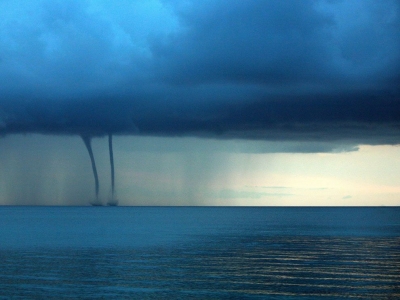
A waterspout is a column of cloud-filled wind rotating over a body of water.
Despite its name, a waterspout is not filled with water from the ocean or lake. A waterspout descends from a cumulus cloud. It does not “spout” from the water. The water inside a waterspout is formed by condensation in the cloud.
There are two major types of waterspouts: tornadic waterspouts and fair-weather waterspouts.
Tornadic waterspouts get their start as true tornadoes. Influenced by winds associated with severe thunderstorms, air rises and rotates on a vertical axis. Tornadic waterspouts are the most powerful and destructive type of waterspout.
Fair-weather waterspouts, however, are much more common. Fair-weather waterspouts are rarely dangerous. The clouds from which they descend are not fast-moving, so fair-weather waterspouts are often static. Fair-weather waterspouts are associated with developing storm systems, but not storms themselves.
Waterspouts exist on a microscale, where their environment is less than two kilometers in width. The cloud from which they develop can be as innocuous as a moderate cumulus, or as great as a supercell. While some waterspouts are strong and tornadic in nature, most are much weaker and caused by different atmospheric dynamics. They normally develop in moisture-laden environments as their parent clouds are in the process of development, and it is theorized they spin as they move up the surface boundary from the horizontal shear near the surface, and then stretch upwards to the cloud once the low level shear vortex aligns with a developing cumulus cloud or thunderstorm. Some weak tornadoes, known as landspouts, have been shown to develop in a similar manner.
Picture Credit : Google




